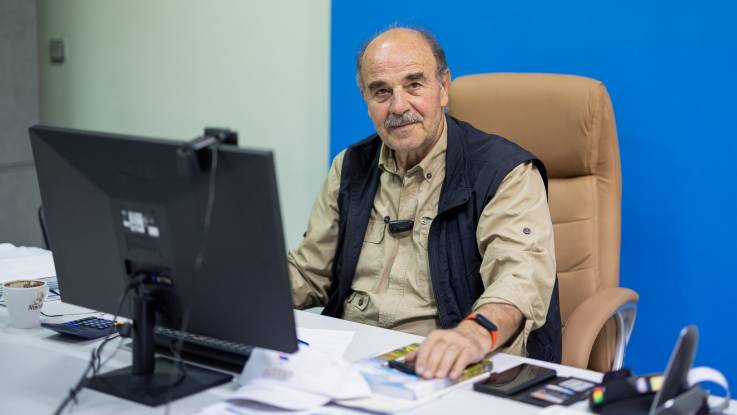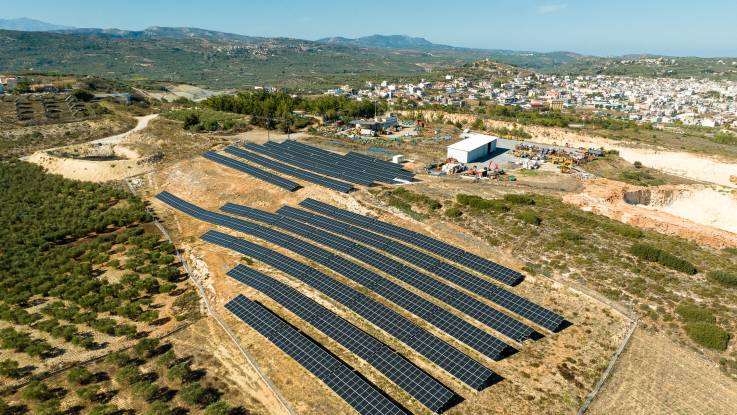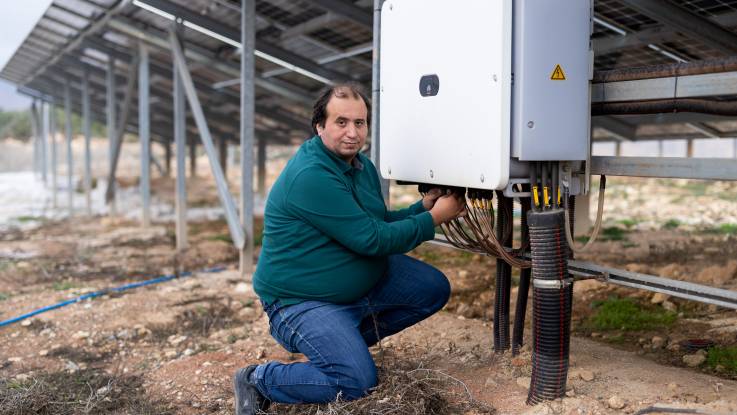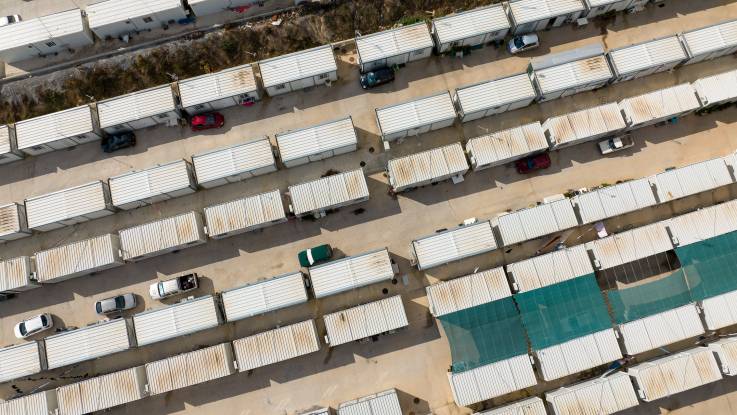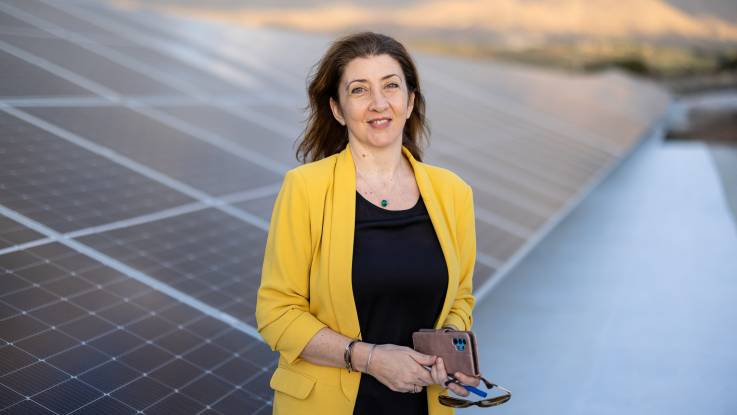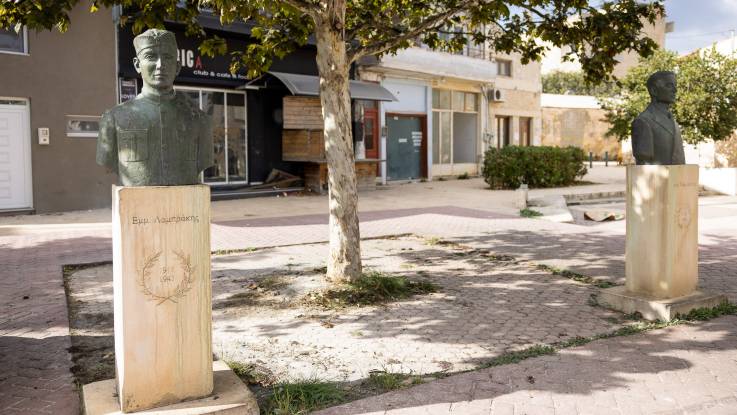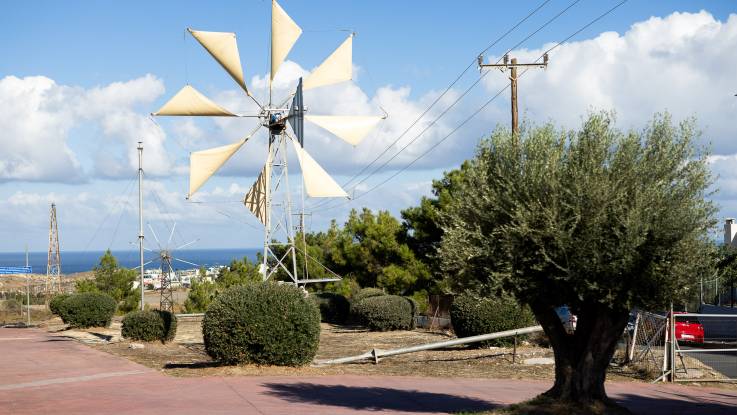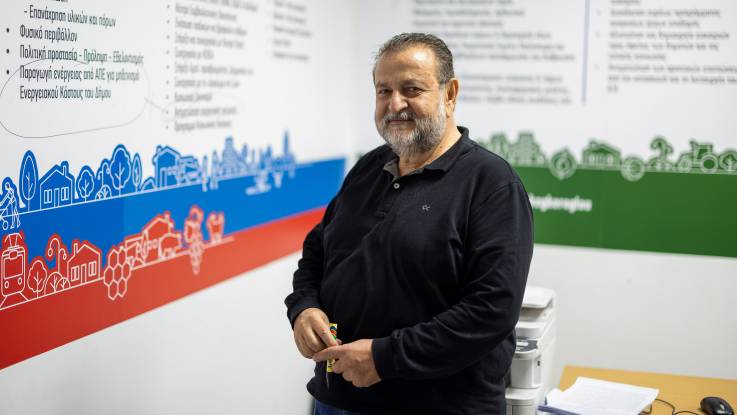The greek miracle of the sun
A report by Rodothea Seralidou
A cooperative on the island of Crete is combining community energy with active solidarity.
Charalambos Giannopoulos leads me through the narrow streets of Arkalochori – a community of 3,000 people in the interior of the island of Crete, around 30 kilometres south of the port city of Heraklion. It is a typical, sunny November day. “The square here would normally be full,” says Giannopoulos. “The cafés would have their tables and chairs set up outside, and people would be drinking coffee and talking about everything under the sun. But that’s all gone.” My guide is 74 years old and sports a neat grey moustache. He is wearing black trousers and a light-brown shirt with the sleeves rolled up. His lively demeanour makes him appear younger than he is. As we walk, he gestures to the ruined or badly damaged homes, closed cafés and shops, and deserted streets. Giannopoulos tells me that the earthquake that hit Crete in September 2021 was particularly devastating for the old stone houses, and that many other buildings that were not immediately destroyed had to be demolished or are still in need of repair. The fact that only one person died despite the magnitude of the earthquake is nothing short of a miracle. “We were lucky that it happened at nine o’clock in the morning when most of us were out of the house, and not in the middle of the night.”
From municipal mayor to new energy pioneer
Giannopoulos knows this place, considered a small town in the Greek context, like the back of his hand: he was mayor here for 20 years, from 1990 to 2010. His mission was always to turn Arkalochori from a sleepy little rural town into a role model for other communities. “Our large open-air theatre, our 50-metre swimming pool, our new sports facilities, the exhibition hall – these were all projects I oversaw as mayor.” And it is indeed remarkable infrastructure for an otherwise rather unassuming location. Tourism has never played a role here, and Arkalochori’s inhabitants live mainly from agriculture.
And yet the community is also pioneering in another area: the energy transition. “Welcome to our office,” says the former mayor, smiling proudly as he invites me into a building bearing a sign that states “Minoan Energy” in orange letters. This is the headquarters of Arkalochori’s energy cooperative. The name is a reference to the rich history of the island, where the earliest advanced civilisation in Europe developed during the Minoan period (2,800 to 900 BCE). The story of King Minos and the Labyrinth of the Minotaur is one of the most famous Greek myths. Minos’ magnificent palace at Knossos, which serves as a reminder of that heyday, is only a roughly 20-minute drive from Arkalochori.
Built on foundations of expertise and friendship
The “Minoa Energiaki Kinotita” (which translates as “Minoan Energy Community”) is Crete’s first energy cooperative. Founded in October 2019, it now has over 750 members, which include private individuals, SMEs and entire municipalities – even a diocese and Crete’s regional authority are involved. The cooperative’s office is unassuming and simply furnished, with black plastic chairs arranged around a conference table and three desks with laptops. On a blue-painted section of the wall hangs the only eye-catching element: an EUSEW Local Energy Action Award certificate, which the cooperative received from the European Union for its sustainable energy production in 2022.
Even as a child, I was fascinated by the power of renewable energies.
“As a little boy, I loved watching the water mills in my village,” recalls agronomist Giannopoulos. “I was transfixed by the sheer power of the water, and realised that there are forces in nature that people can harness for their own benefit.” This idea stayed with Giannopoulos during his time as mayor. But although he could see the enormous potential of renewable energies, he did not know how his municipality could utilise it. So in 2018, when Greek lawmakers passed Europe’s first legislation enabling the establishment of citizen-led energy communities, the former mayor seized the opportunity: he familiarised himself with the new law, visited energy cooperatives in other European countries, and rallied friends and acquaintances to convince them of the benefits and the necessity of joining forces to tackle Crete’s energy issues. The idea for Minoan Energy was born.
Along with other members of the cooperative, Giannopoulos and I visit the Minoan Energy photovoltaic park on the outskirts of Arkalochori. With spirits high and plenty of laughter, it feels like a reunion of good old friends. Among them is Giorgos Viskadouros, a 38-year-old electrical engineer and solar energy expert. “This is our second park, which we installed last July,” he says. It consists of 1,800 solar modules and produces a total of one megawatt of electricity. “Over there is our first, which has a capacity of 405 KWh and has been in operation for a year and a half.”
Interested parties can become members of Minoan Energy with a share worth just 100 euros. But the higher the initial payment, the less the members have to pay for their electricity. The cooperative works according to the “virtual net metering” model, whereby the electricity produced is fed into the grid and offset against the member’s electricity bill. Members only have to pay for power if their consumption is greater than the amount fed in by their share. “If someone wants to become a member, we look at their electricity bills and calculate their household’s approximate consumption,” explains Viskadouros. “A family of four needs around 5,000 kWh per year, which would be supplied by six of these solar panels here.” For that, the family would have to make a one-off investment of around 3,300 euros.
Sharing energy in solidarity among members
Everyone present agrees that this is definitely a worthwhile investment. After all, in normal circumstances 3,300 euros would cover two years of electricity at most, whereas the cooperative share guarantees free electricity for at least 25 years. To ensure that members can keep track of their consumption, the cooperative regularly checks whether they are getting the share of electricity they need. Viskadouros explains: “A hotel, for example, needs more power in the summer months, while an olive press has higher requirements in the winter. We can allocate what is left over from one member to another so that the energy generated is shared and doesn’t go to waste.” So far, the focus has been solely on energy consumption; members do not receive any money from the electricity production. That’s why it’s important to everyone that the electricity generated is allocated in the best possible way.
One very satisfied member of the cooperative is 43-year-old Efi Akoumianaki – Giannopoulos’ niece. While her two young sons tear around the dining room of her spacious home in Arkalochori, she is busy in the open-plan kitchen whipping up a quick pasta dish for the children before heading out to work. Akoumianaki is a Greek teacher and runs a small tutoring centre for schoolchildren. Her house was also damaged in the 2021 earthquake, and the restoration and repairs cost a lot of money: “The fact that we didn’t have to worry about the electricity bill on top of everything else was a real relief,” she says, with a smile. It didn’t take much for the cooperative to convince Akoumianaki to become a member. “Charalambos Giannopoulos is my uncle, which was reason enough for me to join. I know exactly how much he has done for our town and the people here over the years. He is very passionate about environmental protection and the wellbeing of the community.” Akoumianaki also wants her tutoring centre to participate in one of the upcoming projects. “I’m currently working hard to promote the idea, because my business partner also has to agree to it.”
The social connection
The energy cooperative has already gained many private individuals and institutions as members. Now the goal is to reach an even wider audience with the help of the regional authority. As a member of the cooperative, the Region of Crete is funding an education programme run by Minoan Energy to inform the island’s population about the energy transition and the role of the cooperative. “We visit cities, small towns and even the most remote villages across the island, teaching ordinary citizens and schoolchildren about what the energy transition is, how they can contribute to it, and the role of energy cooperatives,” says 52-year-old geologist Ermioni Gialyti.
Gialyti advises the regional authority on topics surrounding renewable energy and is a committed member of the Arkalochori energy cooperative. She travelled straight from Heraklion after work to join us on the tour. She tells us that the Region of Crete also supports households at risk of energy poverty by purchasing shares in the cooperative on their behalf. Around 50 families are currently receiving free electricity as part of the programme. If Giannopoulos had his way, the programme would include even more people. He wants to encourage the regional authority to focus more on families with multiple children, who are already struggling financially and who play an important role in the fight against demographic decline in Crete’s rapidly ageing society. Gialyti likes this idea, too. “Mr Giannopoulos is always one step ahead of the rest of us and is a big advocate for inclusion and social justice,” she says. “He may be the oldest of us all, but he works tirelessly.”
Big plans – and big obstacles
However, in order for as many people as possible to benefit from Minoan Energy membership, the cooperative needs new solar parks. “Three approval processes are currently underway for further projects,” says energy expert Viskadouros. While there are more than enough suitable areas for such parks on Crete, the challenge lies in the island’s inadequate grid infrastructure. The existing power grids quickly become overloaded, which is why projects from small electricity producers are often not approved, explains Giannopoulos: “The big players are given preference when it comes to awarding contracts – often in a process that lacks transparency. If you then apply for another park as a small producer, you are told there is no more capacity.”
We have to fight back to ensure it’s not only the big players who profit from the energy transition.
Giannopoulos says that despite the fact that renewables are particularly well-suited to decentralised energy generation, the Greek government is trying to maintain the old centralised energy model from the days of large fossil-fuelled power plants and is granting large corporations permits for huge solar and wind farms.
The favouring of large plants over smaller community projects is not least due to the Greek government’s ambitious climate target: the country, currently still heavily dependent on gas and oil imports, wants to source 80 percent of its electricity from renewable energies by 2030. That also involves taking the last Greek lignite-fired power plants in the north of the country off the grid by 2028.
Greece is rushing its energy transition – and the people at Minoan Energy fear it could therefore miss out on a huge opportunity for fairer participation for all. “If the energy cooperatives do not push back against the current government policy, ultimately only the big players will benefit from the energy transition – while regular citizens will, as usual, be left out,” warns Giannopoulos, his passion for the topic clear from the rising volume of his voice.
An island of sun, wind, and olives
During our tour of the photovoltaic plant we meet Dimitris Katsaprakakis, a 50-year-old professor of engineering at the Hellenic Mediterranean University in Heraklion. He tells us that Crete’s renewable energy potential is higher than any other region in Europe, citing 300 days of sunshine per year as just one of many advantages. “On Crete, solar energy provides 2,000 kWh of electricity per square metre each year, and there’s also a lot of potential in wind power,” says Katsaprakakis. He looks at the mountains in the distance. “The wind here on Crete reaches speeds of ten metres per second, compared to an average of just five or six for many wind farms in Central Europe.” And then there is the abundant biomass, he says, from sources such as olive trees and olive stones – a rich but so far barely utilised energy resource.
These conditions give Crete an energy potential comparable to that of the Middle East, says Katsaprakakis: “With the difference that our energy sources are practically inexhaustible.” He explains that although 22 percent of Crete’s electricity is already generated from the wind and the sun, those numbers don’t tell the full story: “Ensuring a successful energy transition is one thing, the other is making sure that this wealth benefits us – the people, the small businesses, the communities on our island. That’s what we’re fighting for.” Katsaprakakis lists corruption, a lack of transparency, and lobbying as major obstacles for energy cooperatives. “You see those mountain peaks? We just found out today that a large corporation has already started building wind turbines there even though official approval has not yet been granted.”
This lack of transparency is leading to a deep mistrust of renewables among the population, say the members of Minoan Energy. “People see huge wind turbines being built all around them, but they don’t see any benefits for themselves,” says 34-year-old production mechanic Aris Tsekouras, another member of the cooperative’s science team. “For most people, electricity remains expensive and they are not able to participate in the projects.” That needs to change, explains Tsekouras, as environmental concerns alone are not going to be enough to persuade most of the island’s inhabitants to take an interest in green electricity.
That also accounts for why the energy cooperative became very popular after the outbreak of war in Ukraine, which drove up electricity prices in Greece, too. The economic aspect is decisive, says Tsekouras, especially in a region that has been hit by several crises that have threatened its survival – the Greek government-debt crisis, COVID-19, the earthquake, and the energy crisis.
The Crete Valley pilot project
Driven by the desire to remain innovative into the future, Minoan Energy is also involved in the ambitious Crete Valley pilot project, due to be completed in five years. The goal is that by that time, four villages around Arkalochori will have formed smart, energy-independent “renewable energy valleys” (REVs) that are not connected to the central Cretan power grid, but instead generate and store their own decentralised energy. The REVs will use a mix of renewables including solar power and wind energy from small wind turbines built to resemble the traditional windmills of the region, and district heating and cooling systems will be created, powered by biogas and biomass. This pioneering project is receiving EU funding of 20 million euros. “Some 20 to 50 households will take part in the pilot project in each of the four locations,” explains Viskadouros. The aim, he says, is to then further expand the initiative: “We want to design a digital twin of the project so that it can be implemented in other regions as well.” Ultimately, as many people and communities as possible should be able to actively participate in the ideas of the cooperative and the energy transition. Everyone agrees that hoarding knowledge is not in keeping with the principles of a true energy community.
Vasilis Kegeroglou, the newly elected mayor of Arkalochori, has also called for cooperatives such as Minoan Energy to be prioritised when it comes to the approval of new renewable energy facilities and the amount of energy they are allowed to produce. After all, he says, such cooperatives represent a large part of local society and the municipalities in the region. However, Greek legislation does not yet recognise this. Can Minoan Energy’s fight against domestic and foreign energy giants be seen as a modern form of resistance in a region that has always stood up to external forces? The mayor nods in agreement. Over the course of its history, the island of Crete has resisted many foreign rulers – from the Ottomans to the Venetians and even German occupation during the Second World War.
Democratically organised energy production has a huge impact.
“Parallels can certainly be drawn with the past, as today’s resistance is also about fairness – in this case the fair distribution of green energy,” says the mayor. “Resistance cannot be taken for granted in this day and age,” adds Giannopoulos. “Our grandparents had their own water mills that produced the energy they needed to grind their grain, but nowadays that sort of self-sufficiency is alien to people. They see themselves purely as consumers of energy – and we are trying to change that. Energy production is something everyone can participate in, and democratically organised energy production has great potency.” This is something that Giannopoulos believes more and more people are realising, resulting in increased membership in energy cooperatives – including on Crete.
Before we say our goodbyes, I wonder aloud what will become of the cooperative when the omnipresent Giannopoulos eventually retires as the community’s president. And I’m not the only one with this concern: “I’ve already started thinking about who will take over from me in the future,” says Giannopoulos. “But I have many capable and dedicated colleagues who are just as convinced of the spirit and purpose of our energy cooperative as I am. We share the same ideas – and that’s a very good thing!”
Lead photo: Stelios Misinas / Translated from the German by Grace Winter / Babelfisch Translations. You can also read the report in German.
Related stories
-
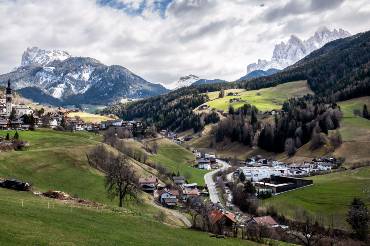
Villnöss – Energy from the community
Fuelled by a cooperative spirit: How a small region in the Dolomites has been successfully meeting its own energy requirements for more than 100 years.
-
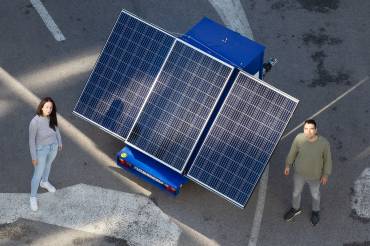
Croatia goes over to the sunny side
Despite its enormous potential, solar energy has yet to get off the ground in Croatia. A green energy cooperative called ZEZ wants to change that.
